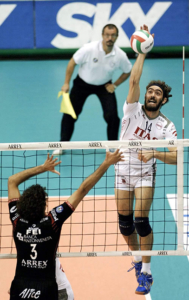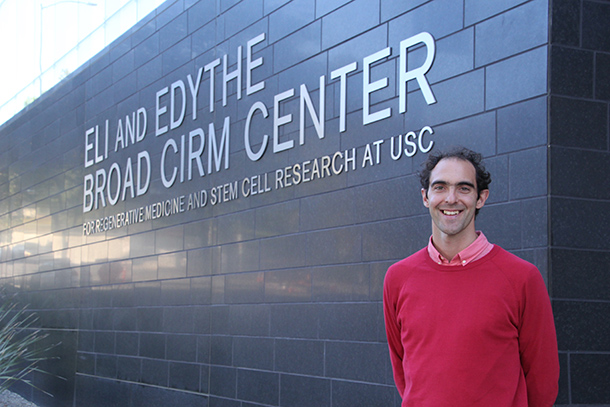
Prior to committing himself full time to research, Leonardo Morsut played professional volleyball.
For Leonardo Morsut, PhD, the word “set” refers to a collection of scientific data. “Set” is also the prelude to spiking a volleyball over the net — something he used to do for a living as a professional athlete in Italy.
“Professional volleyball was always a side project,” said Morsut, assistant professor of stem cell biology and regenerative medicine at the Keck School of Medicine of USC. “It was science that was the main thing.”
True to his words, Morsut has always put research first. Even while playing professional volleyball, he found the time to attend the University of Padova, where Galileo once lectured. He earned bachelor’s and master’s degrees in medical biotechnologies, before pursuing a second bachelor’s degree in mathematics.
At the peak of his athletic career, Morsut quit to pursue a PhD, focusing on mouse gastrulation — the early embryonic phase during which a ball of cells organizes itself into distinct layers as a prelude to organ formation. He then picked up an unrelated side project: how stem cells behave differently depending upon whether they’re on a hard or a soft surface. He and his colleagues’ research revealed that when stem cells are on a hard surface, they react by producing two signals — called YAP and TAZ — that encourage them to become bone cells. Morsut and his team published their discovery in the journal Nature.
Morsut then pursued a postdoctoral fellowship in the laboratory of “synthetic biology” pioneer Wendell Lim, PhD, at the University of California, San Francisco.
“Synthetic biology is pretty much trying to bring the engineering approach of building things into biology,” he said.
He built a synthetic cellular communication system known as “synNotch,” created by co-opting a natural communication system, called Notch, in which a cell uses a sensor on its surface to recognize and trigger a particular response to a specific signal. In Morsut’s synthetic version, he swapped in a new sensor to control what the sensor recognizes, as well as what the cell does in response — a breakthrough that could have many medical applications, such as engineering cells to recognize and attack tumors.
While this breakthrough earned Morsut a position at USC Stem Cell, his wife Sabina also accepted a postdoctoral fellowship in art history at USC and the couple, who originally met when they were 12 years old in Padova, will welcome their second child this June.
At USC, Morsut plans to use synNotch to direct the differentiation of stem cells into blood vessels that can support engineered organs, as well as develop additional synthetic biology tools, and said he looks forward to collaborating with researchers at the USC Viterbi School of Engineering and the USC Michelson Center for Convergent Bioscience, slated to open in fall 2017.
— Cristy Lytal


